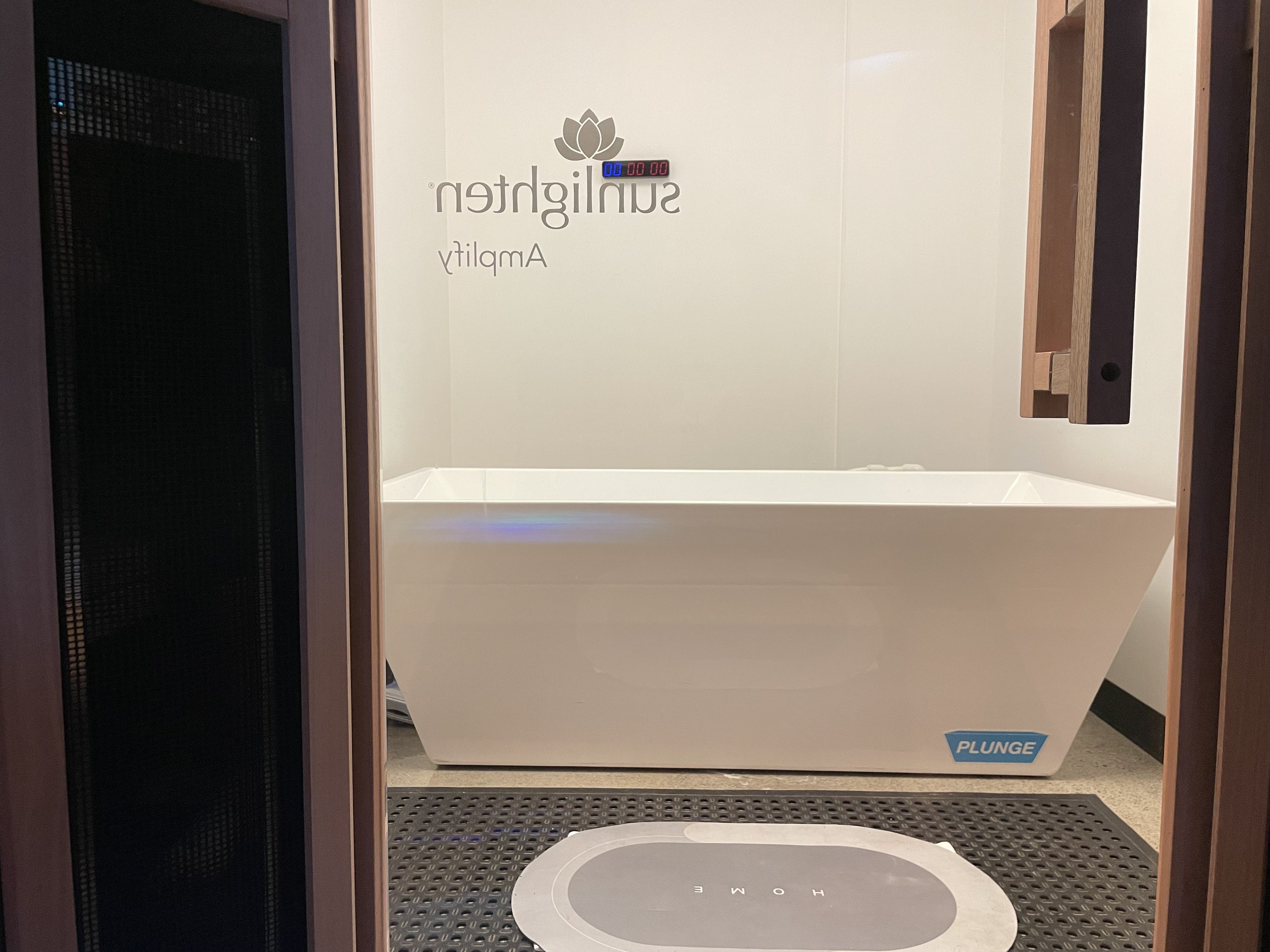Maximizing Athletic Recovery with Contrast Therapy: The Sauna to Ice Bath Experience
As exercise enthusiasts, we're always pushing our bodies to the limit in pursuit of our fitness goals. But with great effort comes great responsibility – to properly recover and support our bodies in their journey toward peak performance. Enter contrast therapy, a time-tested method that utilizes hot and cold treatments to enhance recovery, reduce inflammation, and promote healing. In this blog post, we'll explore the benefits of contrast therapy, dive into the process of transitioning from a hot sauna to an ice bath, explore alternative methods, and examine its role in injury recovery, including the remarkable journey of athletes like Kobe Bryant.
Understanding Contrast Therapy:
Contrast therapy involves alternating between hot and cold treatments to stimulate circulation, reduce inflammation, and accelerate recovery. The contrast between the two temperatures creates a "pumping" effect in the blood vessels, flushing out metabolic waste products and delivering fresh oxygen and nutrients to the muscles.
My Contrast Therapy Protocol: Sauna to Ice Bath
Step into the Sauna: Start your contrast therapy session by spending 10-20 minutes in a hot sauna or steam room. The duration is unique to the individual. The visual I give to my clients is that feeling you get when you're fully submerged in a jacuzzi and you get to sit up. That’s the time you are ready to plunge. The heat from the sauna helps relax muscles, improve circulation, and promote sweating, which aids in cleansing.
Embrace the Cold: Now it's time to brave the cold. Take a deep breath in and as you submerge yourself in an ice bath begin to exhale slowly. If this is my client’s first time the goal is 1-3 minutes. The cold temperature constricts blood vessels, reduces inflammation, and numbs pain, providing immediate relief for sore muscles and joints.
Rest: This is an important step, do not skip it and hop back in the sauna. Skipping the rest phase can diminish the effectiveness of the therapy and increase the risk of discomfort or injury. It's essential to adhere to the recommended protocol, including proper rest intervals, to ensure safe and effective treatment outcomes.
Repeat: Cycle of hot and cold treatments 2-3 times, with each cycle lasting approximately 20-30 minutes. Be sure to listen to your body and adjust the duration of each treatment based on your comfort level and tolerance.
If you live locally in Newport Beach, CA I hope you come visit our facility. Book your appointment
HERE and use code: 50OFF for your first service!
If you don’t live locally and there aren’t any facilities around you that offer contrast therapy you can still reap its benefits.
Alternative Methods:
While the sauna-to-ice bath experience is a classic contrast therapy approach, there are alternative methods that offer similar benefits. Here are a few to consider:
Beach Walk/Ocean Dip
Start by taking a leisurely walk on the beach and gradually increase your speed to increase your body temperature and promote circulation. The combination of fresh air, sunlight, and gentle movement helps relax muscles and reduce stress, while the sandy terrain provides natural resistance for an added workout. After 5-10 minutes of
your beach walk, cool off by wading into the water. The cold water provides a refreshing contrast to the warmth of the sun, stimulating circulation and invigorating the body. Plus, the buoyancy of the water helps alleviate pressure on joints and muscles, making it an ideal recovery option for athletes. The water also creates uniform pressure on all sides. This pressure helps improve circulation, reduce swelling, and alleviate muscle soreness. Unlike cryo chambers, which use cold temperatures to numb pain and reduce inflammation, hydrostatic pressure therapy provides a more comprehensive approach by promoting blood flow and aiding in recovery from physical exertion. Additionally, hydrostatic pressure therapy is generally well-tolerated and doesn't pose risks associated with extreme cold exposure.
2. Hot and Cold Shower:
For a quick and convenient contrast therapy session, try alternating between hot and cold water in the comfort of your own home. Start with a hot shower for 2-3 minutes, then switch to cold water for 1-2 minutes. Repeat the cycle 2-3 times, finishing with a cool rinse to seal in the benefits.
Benefits of Contrast Therapy: Now that we've covered the process and alternative methods, let's explore the numerous benefits of contrast therapy:
Improved Circulation: The alternating hot and cold treatments in contrast therapy promote vasodilation and vasoconstriction, which improves blood circulation and nutrient delivery to the muscles. This increased blood flow helps remove metabolic waste products like lactic acid, reducing muscle soreness and fatigue.
Reduced Inflammation: Cold therapy helps constrict blood vessels and reduce inflammation, while hot therapy promotes relaxation and soothes sore muscles. By alternating between hot and cold treatments, contrast therapy effectively reduces inflammation and accelerates the body's natural healing process.
Enhanced Muscle Recovery: Contrast therapy helps speed up muscle recovery by enhancing circulation, reducing inflammation, and promoting relaxation. This allows athletes to bounce back faster from intense workouts and perform at their best day after day.
Pain Relief: Cold therapy numbs pain and reduces swelling, providing immediate relief for sore muscles and joints. Hot therapy, on the other hand, helps relax tense muscles and alleviate stiffness, further reducing discomfort and improving mobility.
Injury Prevention: By promoting circulation, reducing inflammation, and improving muscle recovery, contrast therapy helps prevent injuries caused by overuse, fatigue, and muscle imbalances. Incorporating contrast therapy into a regular recovery routine can help athletes stay healthy and injury-free long-term.
Kobe Bryant and Contrast Therapy: One of the most famous examples of contrast therapy's effectiveness in injury recovery is Kobe Bryant's remarkable comeback from an Achilles injury. After suffering a ruptured Achilles tendon in 2013, Bryant underwent surgery and embarked on a rigorous rehabilitation program that included contrast therapy as a key component.
Contrast therapy helped Bryant manage pain, reduce inflammation, and accelerate healing during his recovery process. By alternating between hot and cold treatments, Bryant was able to improve circulation to the injured area, reduce swelling, and promote tissue repair – ultimately allowing him to return to the court stronger than ever.
A study published in the National Center for Biotechnology Information found that contrast therapy “is superior to using passive recovery or rest after various forms of exhaustive or damaging exercise. The benefits relate to a reduction in muscle soreness, and improved muscle function due to an attenuation of muscle strength loss and muscle power loss after exercise.”
Check out these other active recovery techniques in our blog post: “What Helps Sore Muscles After A Workout or Injury? The 3 BEST Therapies to Improve Athletic Recovery…”
Contrast therapy offers exercise enthusiasts a powerful and effective method for enhancing recovery, reducing inflammation, and preventing injuries. Whether you prefer the classic sauna to ice bath experience or opt for alternative methods like a beach walk or hot and cold shower, contrast therapy provides a wide range of benefits that can help athletes perform at their best and recover faster after intense workouts. With scientific studies supporting its efficacy and real-world examples like Kobe Bryant's remarkable.
Below are some of the common questions my clients ask when considering if contrast therapy is right for them.
-
Overall, contrast therapy may have benefits for certain aspects of recovery and general health, its potential drawbacks should be carefully considered, particularly if muscle gain is the primary goal. This is because muscle growth is partly facilitated by the inflammatory response triggered by exercise. Cold therapy can potentially dampen this response by reducing inflammation, which may interfere with the muscle repair process and ultimately hinder muscle growth.
-
Ultimately, the choice between contrast therapy and ice baths depends on factors such as personal preference, accessibility, and individual response to each method. It's essential to listen to your body and choose the recovery method that works best for you.
-
The frequency of contrast therapy can vary depending on individual factors such as fitness level, tolerance to temperature extremes, and specific goals. However, a general guideline for contrast therapy sessions is to incorporate them into your routine is at lease one 60 minute session per week with a sauna time totaling 40 minutes and ice bath time totaling 10 minutes with 5 minute session in-between sauna and ice bath.



